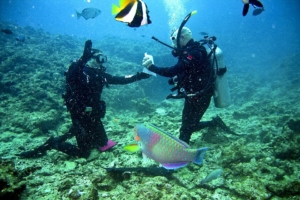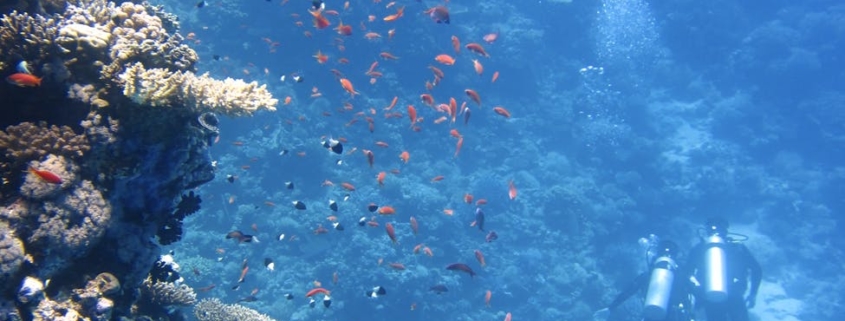Unless you’re performing a solo dive, you’ll probably be paired up at least one other diver. While you can always converse with other divers on the boat, this isn’t always possible once you’re in the water. Sound waves still travel through the water. In fact, they travel approximately 500% faster in the water than in the air. The problem is that underwater sound waves don’t trigger the same vibrations in your inner ear as those in the air, so you can’t hear as easily when diving. With that said, there are still several ways to communicate with other divers after descending below the surface.
The Importance of Underwater Communication
 Although it sounds like a meaningless skill, knowing how to communicate with other divers below the surface is important for several reasons. First, it allows you to convey potential hazards that could otherwise cause injury to either yourself or another diver. If you are running low on air, you can inform your buddy so that you can use his or her regulator. If you want to travel in a different direction, you can communicate this to your buddy so that he or she can follow you.
Although it sounds like a meaningless skill, knowing how to communicate with other divers below the surface is important for several reasons. First, it allows you to convey potential hazards that could otherwise cause injury to either yourself or another diver. If you are running low on air, you can inform your buddy so that you can use his or her regulator. If you want to travel in a different direction, you can communicate this to your buddy so that he or she can follow you.
You can also use underwater communication to notify your buddy about the presence of marine life. While shark attacks involving divers are incredibly rare — especially when diving in groups rather than alone — most divers want to keep a safe distance from these majestic sea creatures. Using the right method of underwater communication, you can let your buddy know if there’s a shark approaching.
Let’s face it, underwater communication makes diving more enjoyable. If you aren’t able to communicate, you won’t be able to fully share the diving experience with your buddy. For these reasons and others, you should learn at least one method of underwater communication.
Hand Signals
Perhaps the easiest way to communicate when diving is to use hand signals. The World Recreational Scuba Training Council has created a set of universal hand signals for divers. Using hand gestures, you can convey information to your dive buddy. It’s an easy yet effective way to communicate when diving.
Some of the most common hand signals used to communicate when diving include the following:
- Thumbs Up: Raising a single hand and using the thumbs up gesture means you want to ascend.
- Thumbs Down: Conversely, raising and single hand and using the thumbs down gesture means you want to descend.
- OK: Creating a circle with one hand by closing your thumb and index finger means you are safe or okay.
- Hands Over Head: Another way to convey that you are safe or okay is to place both hands over your head. This method is preferred when underwater visibility is limited, as it’s easier for divers to see than the OK hand signal.
- Raised Hand With Palm Exposed: Raising a single hand with the palm exposed means stop.
- Raised Index Finger Turning in a Circular Motion: Raising an index finger and turning it in a circular motion means you want to turn around or reverse direction.
- Both Hands Cupped Together: Placing both hands in front of your body and cupping them together means you want to return to the boat.
- Single Hand Moving Horizontally Across Throat: Placing a single hand and moving horizontally across your throat means you are out of gas or running out of gas.
Dive Slate
Another way to communicate when diving is to use a dive slate. Consisting of an erasable board or waterproof paper, you can use a dive slate to write messages. Whether you want to convey information to your buddy or ask him or her question, you can use a dive slate. Just write your message on the dive slate and point it in his or her direction.
You can’t use just any pen and paper to communicate when diving. Unless it’s waterproof, your messages won’t appear on the board or paper. Dive slates solve this problem by featuring a completely waterproof design. They are typically made of PVC or plastic and feature a waterproof erasable marker or pencil. Some dive slates even use glow-in-the-dark markers or pencils, allowing you to produce easy-to-see messages.
The only disadvantage to using a dive slate is that it requires you to haul additional equipment. If the dive slate isn’t secured to your suit, it may fall off. But if you’re looking for a quick and easy way to communicate when diving, you can’t go wrong with a dive slate. Just remember to keep it secure at all times. Depending on where you are diving, you may lose your dive slate forever if it falls off.
Lights
 While not as effective as hand signals or a dive slate, lights can also be used to communicate when diving. A dive light is a special type of handheld flashlight that’s designed to illuminate your surrounding environment when diving. If you’re diving at night, you can use a dive light to increase your visibility. But dive lights are also an effective means of underwater communication.
While not as effective as hand signals or a dive slate, lights can also be used to communicate when diving. A dive light is a special type of handheld flashlight that’s designed to illuminate your surrounding environment when diving. If you’re diving at night, you can use a dive light to increase your visibility. But dive lights are also an effective means of underwater communication.
Some of the most common light signals include the following:
- Drawing a Circle on the Ocean Floor: Moving your light in a circular manner on the ocean floor means you are safe or okay.
- Moving Light Up and Down: Quickly raising and lowering the light means danger ahead.
- Moving Light Side to Side: Moving the light horizontally from side to side means you’ve encountered an emergency.
Voice System
There are voice systems available that allow divers to communicate with each other. Using a voice system, you can talk to your buddy just as you normally would when on the boat or on land. Voice systems are typically embedded in or attached to your dive mask. They consist of both a microphone and speaker. To relay a message to your buddy, you speak into the microphone. Your buddy will then hear your message through the speaker attached to his or her dive mask.
An example of a voice system used in diving is the Lagosease. Developed by Casio, it works within visible range. In other words, if you see your buddy, you can speak to him or her and vise versa. But if your buddy is too far away to see, you won’t be able to communicate with him or her using Casio.
The downside to using a voice system like Casio is that it requires you to keep the regulator in your mouth. As a result, you may struggle to speak clearly. With practice, though, you can learn to speak more clearly so that your buddy can understand what you are saying.
Rope Tugs
You can’t communicate with other divers using rope tugs, but you can use this method to communicate the boat operator or tender. If the tender pulls on the rope once, he or she is asking if you are okay. If you pull on the rope once, you are signaling to the tender that you are okay.
If the tender pulls on the rope twice, he or she is telling you to stay where you are. If you pull on the rope twice, you are signaling to the tender that you are stationary.
Want to create your own custom dive logs? Contact us today to learn more about our custom dive logs.



